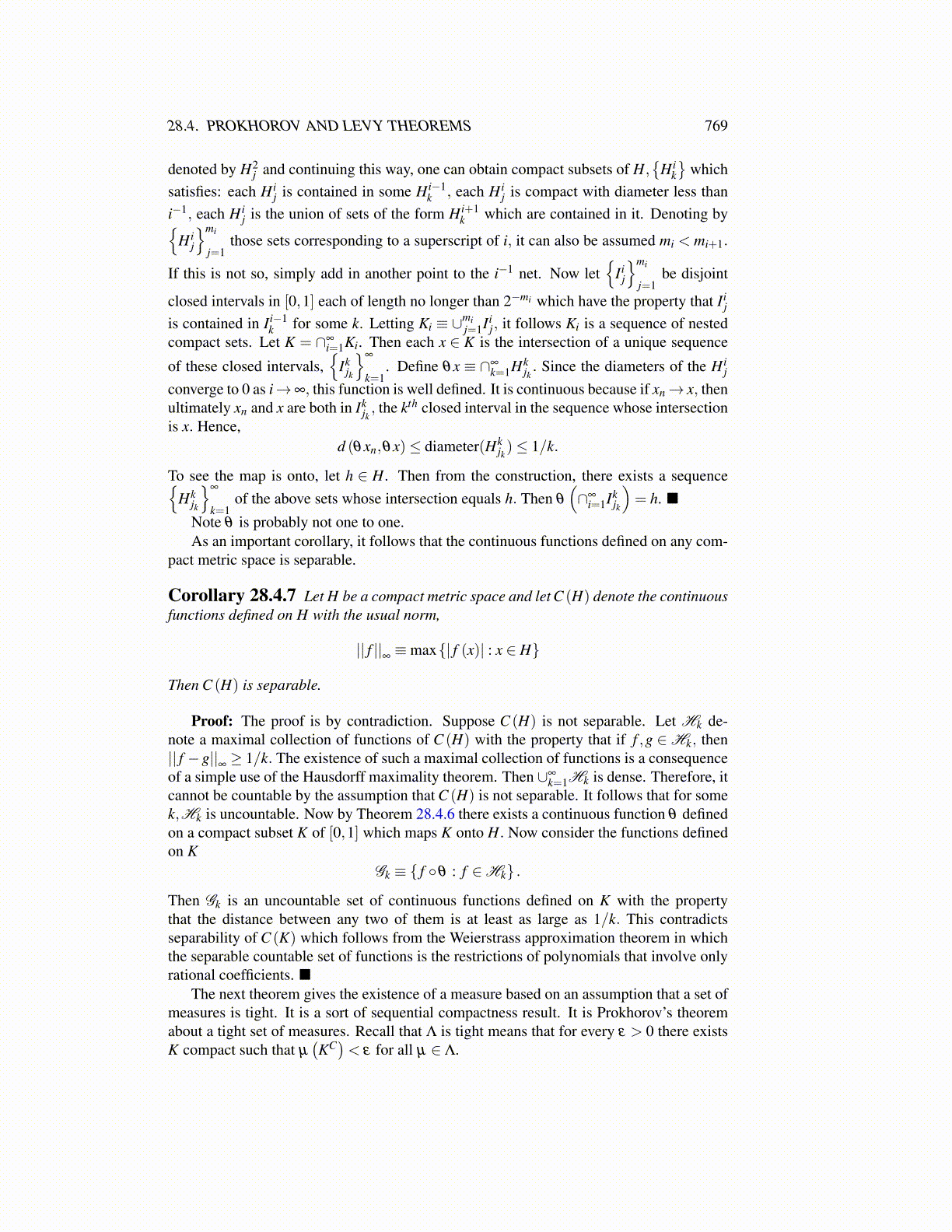
28.4. PROKHOROV AND LEVY THEOREMS 769
denoted by H2j and continuing this way, one can obtain compact subsets of H,
{H i
k
}which
satisfies: each H ij is contained in some H i−1
k , each H ij is compact with diameter less than
i−1, each H ij is the union of sets of the form H i+1
k which are contained in it. Denoting by{H i
j
}mi
j=1those sets corresponding to a superscript of i, it can also be assumed mi < mi+1.
If this is not so, simply add in another point to the i−1 net. Now let{
Iij
}mi
j=1be disjoint
closed intervals in [0,1] each of length no longer than 2−mi which have the property that Iij
is contained in Ii−1k for some k. Letting Ki ≡ ∪mi
j=1Iij, it follows Ki is a sequence of nested
compact sets. Let K = ∩∞i=1Ki. Then each x ∈ K is the intersection of a unique sequence
of these closed intervals,{
Ikjk
}∞
k=1. Define θx ≡ ∩∞
k=1Hkjk. Since the diameters of the H i
j
converge to 0 as i→∞, this function is well defined. It is continuous because if xn→ x, thenultimately xn and x are both in Ik
jk, the kth closed interval in the sequence whose intersection
is x. Hence,d (θxn,θx)≤ diameter(Hk
jk)≤ 1/k.
To see the map is onto, let h ∈ H. Then from the construction, there exists a sequence{Hk
jk
}∞
k=1of the above sets whose intersection equals h. Then θ
(∩∞
i=1Ikjk
)= h. ■
Note θ is probably not one to one.As an important corollary, it follows that the continuous functions defined on any com-
pact metric space is separable.
Corollary 28.4.7 Let H be a compact metric space and let C (H) denote the continuousfunctions defined on H with the usual norm,
|| f ||∞≡max{| f (x)| : x ∈ H}
Then C (H) is separable.
Proof: The proof is by contradiction. Suppose C (H) is not separable. Let Hk de-note a maximal collection of functions of C (H) with the property that if f ,g ∈Hk, then|| f −g||
∞≥ 1/k. The existence of such a maximal collection of functions is a consequence
of a simple use of the Hausdorff maximality theorem. Then ∪∞k=1Hk is dense. Therefore, it
cannot be countable by the assumption that C (H) is not separable. It follows that for somek,Hk is uncountable. Now by Theorem 28.4.6 there exists a continuous function θ definedon a compact subset K of [0,1] which maps K onto H. Now consider the functions definedon K
Gk ≡ { f ◦θ : f ∈Hk} .
Then Gk is an uncountable set of continuous functions defined on K with the propertythat the distance between any two of them is at least as large as 1/k. This contradictsseparability of C (K) which follows from the Weierstrass approximation theorem in whichthe separable countable set of functions is the restrictions of polynomials that involve onlyrational coefficients. ■
The next theorem gives the existence of a measure based on an assumption that a set ofmeasures is tight. It is a sort of sequential compactness result. It is Prokhorov’s theoremabout a tight set of measures. Recall that Λ is tight means that for every ε > 0 there existsK compact such that µ
(KC)< ε for all µ ∈ Λ.